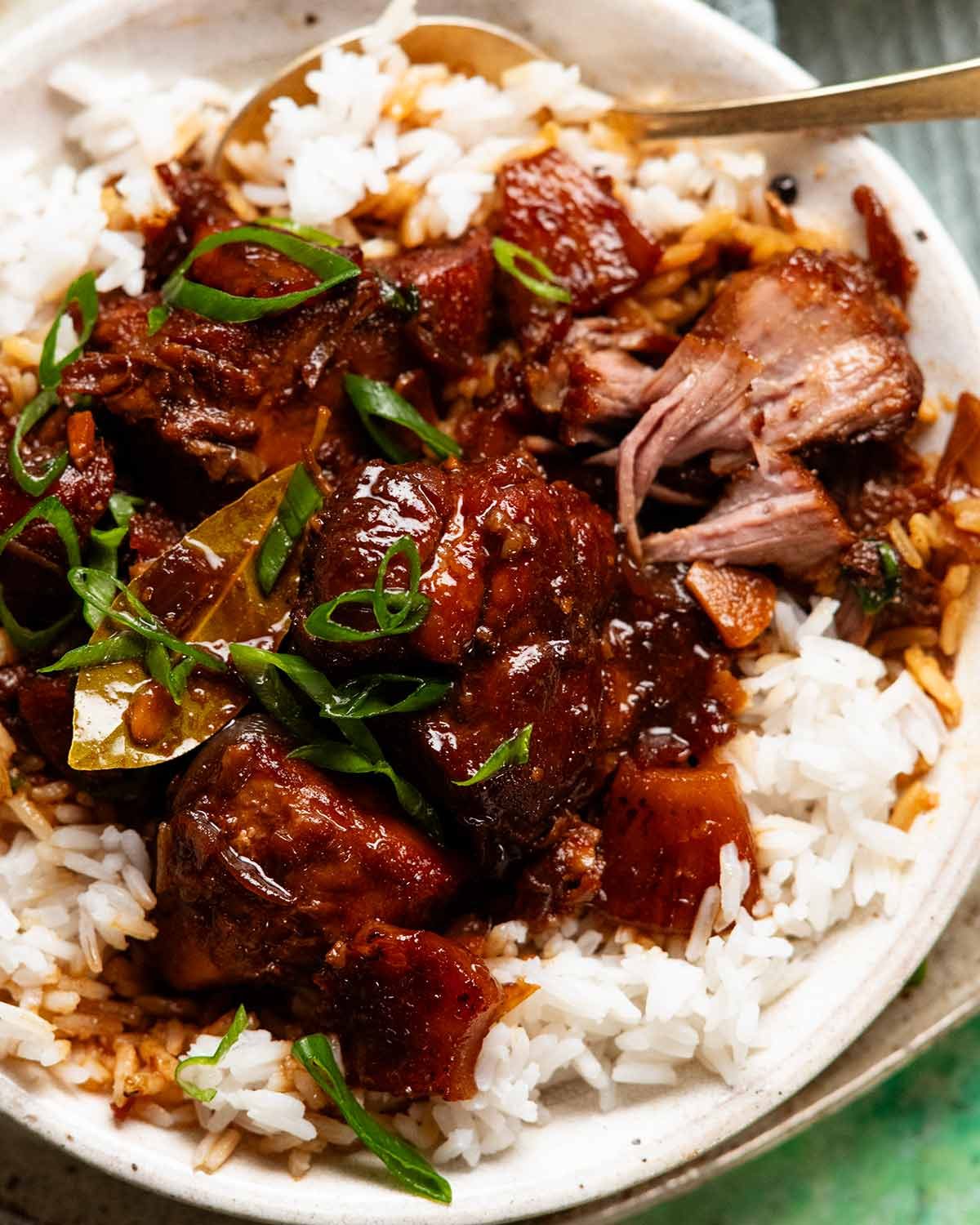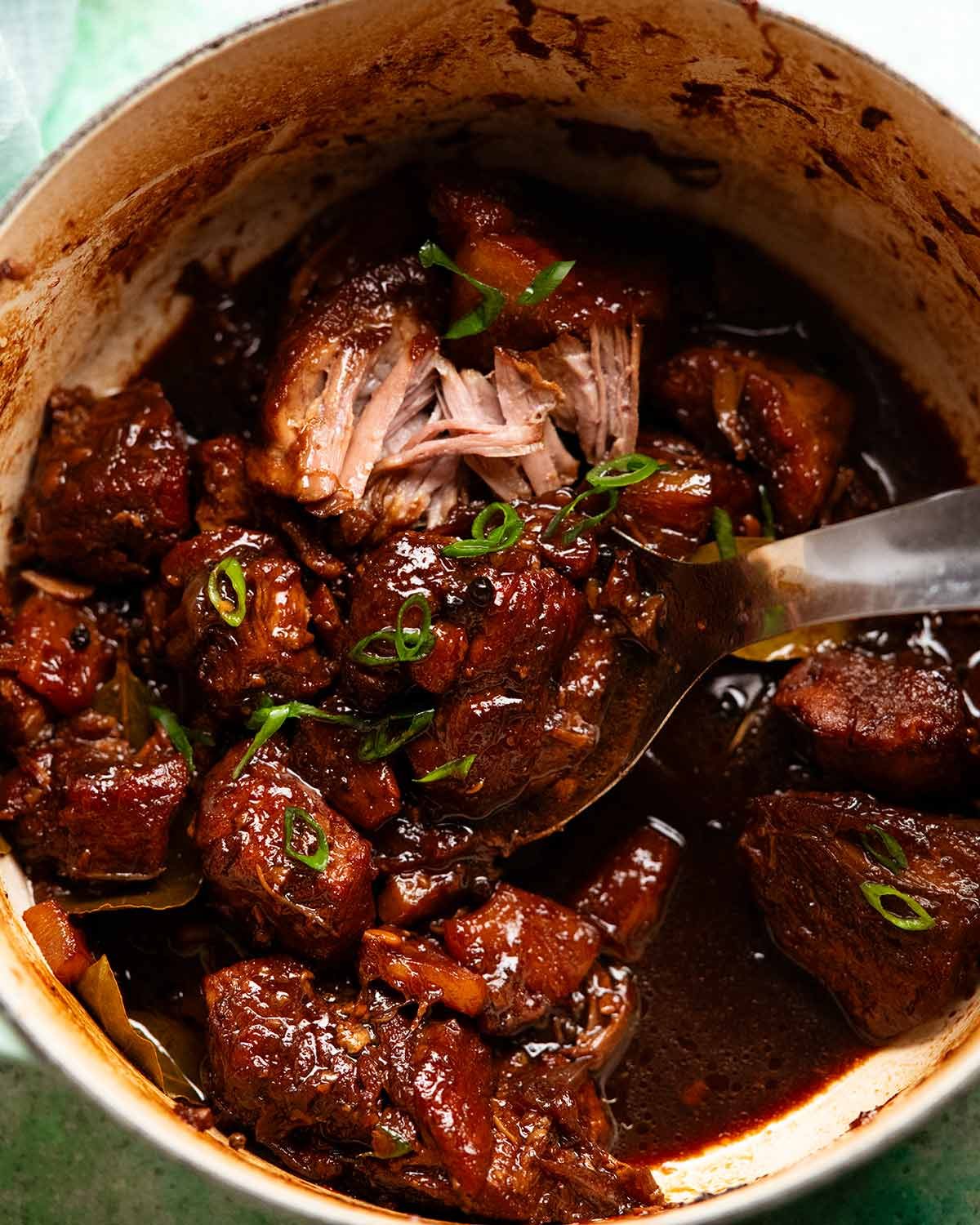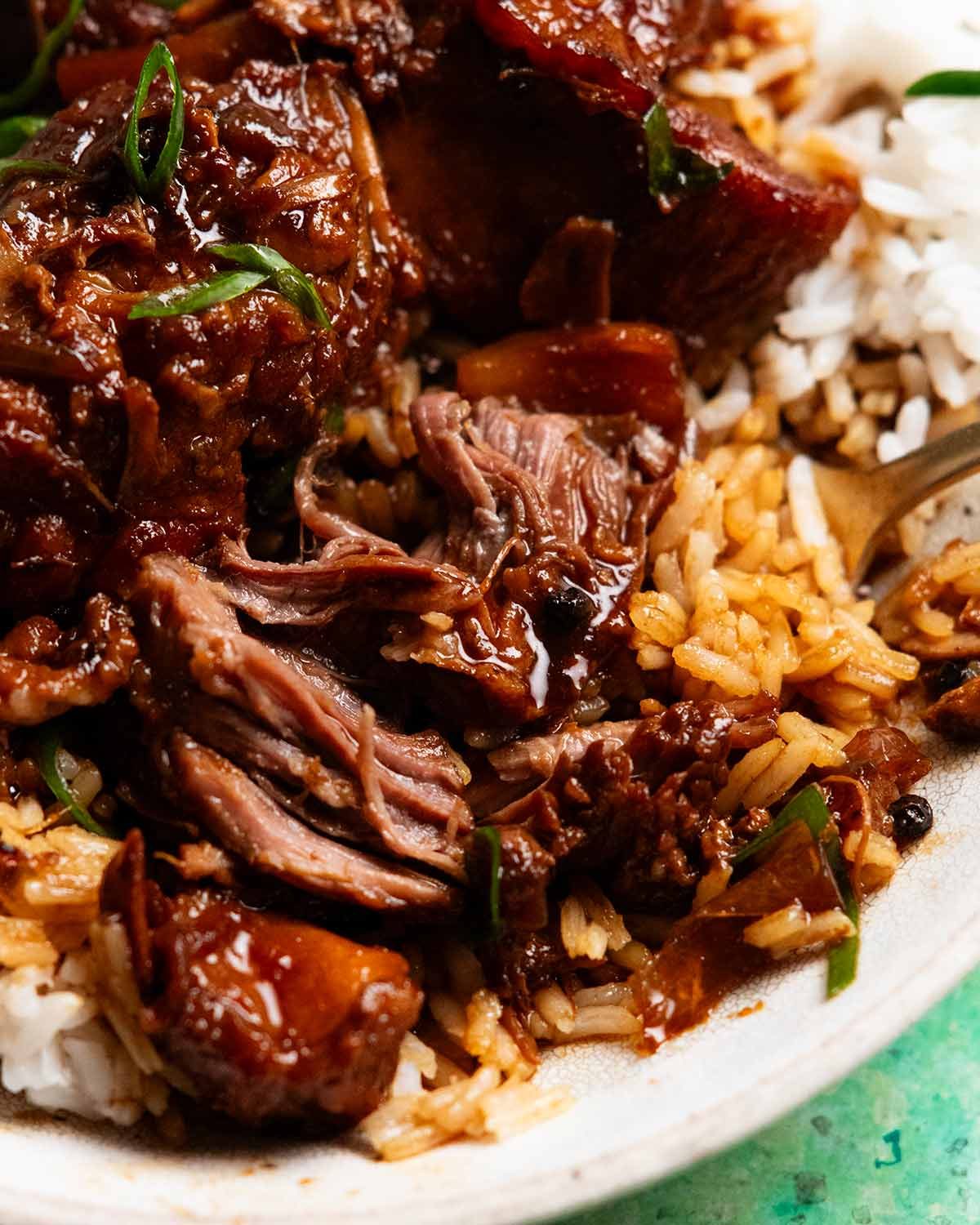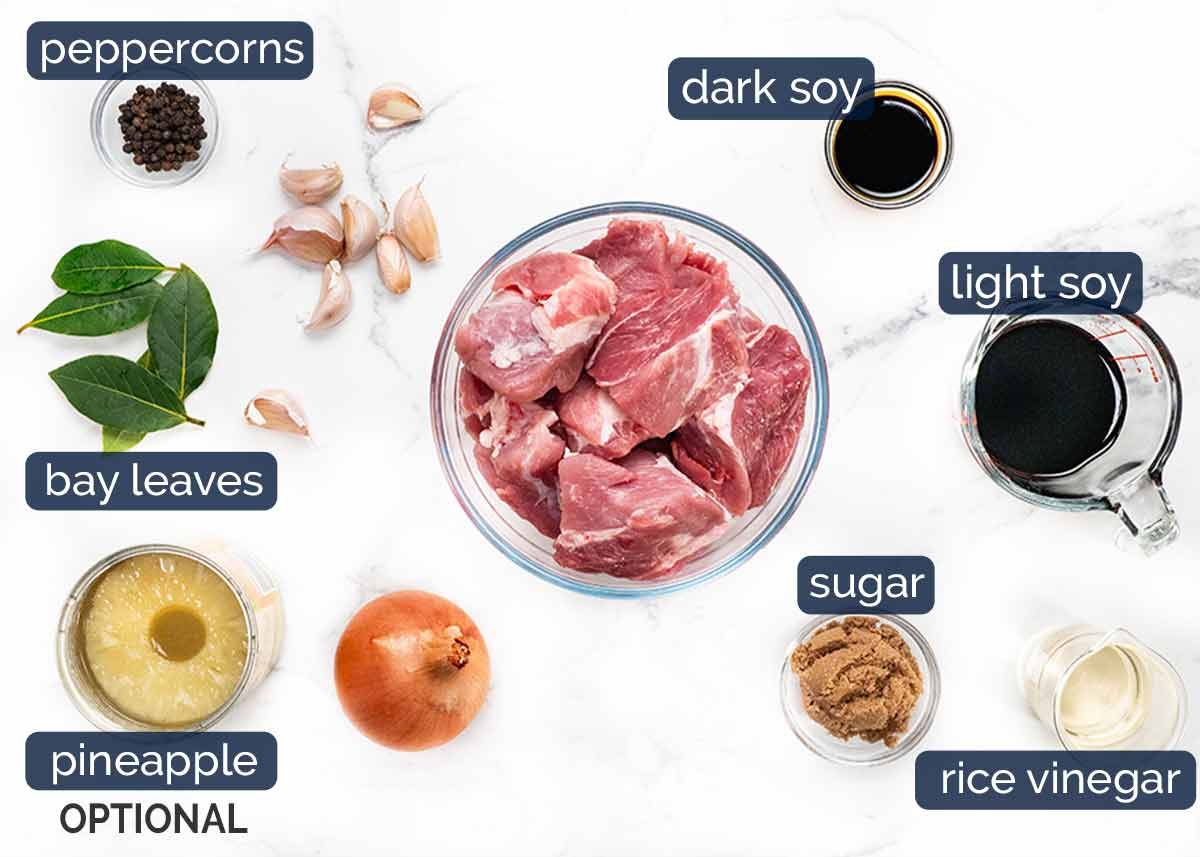Pork Adobo is the pride of the Philippines – one bite and you’ll be hooked! Meltingly tender pork is slow cooked until fall-apart in an intense soy-garlic sauce that reduces down to a glaze, then served over steaming rice. This is food so good yet so simple to make, you’ll be shaking your head in disbelief.

The Filipino are genius!
Adobo is the national dish of the Philippines, and they have every reason to be proud of it! It’s a dish comprised of pork chunks braised in a garlic-soy flavoured liquid that reduces down into an intense flavoured glaze-like sauce. The pork is fork-tender, stained a rich mahogany colour, and when it’s served over a pile of hot steamed rice, you’ll understand why this is a national treasure.
At its heart, it’s a simple, homely dish, and therein lies the genius – that something so easy with so few ingredients can be so incredible. It’s a one-pot recipe that’s hands-off, and the sauce just calls for pantry staples – soy, garlic, onion, vinegar, sugar, pepper and bay leaves.
Oh, and pork! 😅
Recipe credit goes to my brother Goh – RecipeTin’s tech wizard and ace of world food recipe development! He’s sacrificed his waistline eating his way through countless Adobos in the Philippines and Sydney, in pursuit of creating our perfect Pork Adobo I’ve been chasing for years.

tell me about filipino adobo!
Adobo is the national dish of the Philippines, and the country’s best-known food export. There are actually many dishes called “adobo” in the Philippines – some have coconut milk, some are soupy while others are dry-style and glazed, like my Chicken Adobo, a long standing reader favourite and probably the type of Adobo most people outside the Philippines are familiar with.
What pork adobo tastes like – The classic and most common adobo is made with the key ingredients of soy, vinegar and a touch of sugar. Like many traditional foods, Adobo is one of those dishes where every household makes it their own way, to their own tastes, and today’s version is how we like it. We prefer Adobo with a more rounded flavour where it’s mostly savoury with just enough vinegar for brightness without being overly sour (some restaurant are so sour!) and not too sweet (again, some restaurants are tooth-achingly sweet!).
The Adobo sauce has an intense flavour which is the way it’s supposed to be: on the stronger side but without being overly salty. The idea is you eat Adobo with plenty of rice and serve with modest amounts of sauce rather than drowning your rice in sauce.

Ingredients in Pork Adobo
Here’s what you need to make Pork Adobo. I bet you’ve got all the sauce ingredients in your pantry right now! Pineapple is optional – read below for background (yes, some Filipino recipes have it!).

Pork meat – Pork belly is the most common cut used for pork adobo, but I personally prefer pork shoulder for the same fall-apart-juicy meat but less fatty. Shank/knuckle or forequarter chop meat also works really well. Pork neck/scotch is excellent too but reduce simmering time to 1 hour (it doesn’t need slow cooking as long).
Cut the pork shoulder into large 6 – 7cm / 2.5″ cubes. Larger is better so they don’t become “fall-apart” too quickly. Longer and slower cook = more tender, juicier meat and better flavour in the sauce.
Other proteins – Yes, this recipe can be used for other slow cooking proteins. See FAQ! For chicken, use my Chicken Adobo recipe.
Soy sauces – The light soy sauce is the primary soy used here which adds salt and umami without an overwhelming soy flavour. The dark soy sauce darkens the colour of the sauce to almost black. Dark soy is quite intense so we don’t need much – only 1 1/2 teaspoons.
You can substitute the dark soy with more light soy sauce, but don’t substitute the light soy with dark soy sauce because it will too dark and too intense, it will ruin the dish! More about difference soy sauces here.
Brown sugar – This provides the sweetness in the sauce. White sugar can be used instead though brown is better because it adds a smidge of caramel-y flavour. Honey can also be substituted but reduce quantity to 2 1/2 tablespoons.
Rice vinegar – The addition of vinegar is what makes adobo unique and distinctly Filipino. It adds backbone and sharpens the sauce, but in a rounded way as the long braising softens the acidity. Feel free to use other kinds of vinegar. White wine, apple cider, or plain old white vinegar will all work. Vinegars can vary a lot in their intensity, amongst types as well as even brands. So start with the amount per the recipe, then taste towards the end of cooking. If you prefer a little more sharpness, you can add a teaspoon at a time to taste.
Some adobos are deliberately quite tangy, but we prefer a gentler acidity. We use just enough to bring brightness without being overly sour. We sampled some from restaurants that were so sour, we found it was too much and difficult to eat!
Black peppercorns – Whole peppercorns are traditional but not essential in my view. If you don’t like biting into whole peppercorns (I personally love the spicy pops!), you can either add a good pinch of ground black pepper, or leave it out.
Pineapple – Dear Filipinos, I know, I know. This is NOT a very common ingredient in traditional pork adobo. However I saw it included in a few modern versions and frankly, after trying it I fell in love with it as an addition. It provides a delicious sweet and fresh counterpoint to the richly-flavoured pork and sauce, not to mention some welcome colour to what is otherwise a uniformly brown dish (no shade at brown dishes, of course!!)
If you can get your hands on freshly cut pineapple of course that’s best. Otherwise, canned pineapple does a perfectly acceptable job and is what I use. I like bigger chunks cut from rings, but smaller pre-cut pieces will also do fine if that’s all you have.
Bay leaves – You wouldn’t think of bay leaves as having a place in South East Asian cooking! This is a legacy of the Spanish colonial influence on Filipino cuisine. They’re optional if you don’t have any. Fresh is better if you can (it’s an excellent low-maintenance plant, if you want to grow your own!), else dried is fine.
Water – Not shown. Sorry. Because I know you’ve got some! (I’m talking regular tap water here, not a fancy hard-to-find Filipino water!)
How to make pork adobo
It’s an incredibly low-effort recipe. More national dishes need to be this hands-off! 😁

Sear – Using a large heavy based pot, sear the pork in two batches over high heat until nicely golden all over. Take about 4 minutes to do each batch, turning as needed to sear each side and get some nice golden colour on it. Remove to a bowl and reserve residual fat in the pot.
Sauté the onion until it softens, adding the garlic towards the end.

Braising liquid – Add the water, soy sauces, vinegar, sugar, bay leaves and peppercorns. Return the pork and any meat juices accumulated in the bowl to the liquid. Bring it to a boil, then lower the heat so the liquid is simmering gently (ie. a few slow-ish bubbles, not rapid small bubbles). More gentle heat = more gentle cooking = more succulent meat.
Slow cook 1 1/2 hours – Partially cover the pot with a lid – by this, I mean place the lid on off centre to leave a crack about 2cm / 1″ – and simmer gently for 1 1/2 hours or until the pork is tender and can easily be pried apart. If it’s still not tender, keep simmering until it is!

Proof of fall apart pork!
Remove the pork with a slotted spoon (it’s ok if the onion stays).

Reduce sauce – Then increase the heat and boil the sauce to reduce down to about 1 1/2 cups (375 ml), about 8 minutes. The exact time this takes will vary, it depends on how much liquid you start with, strength of stove etc.
Adobo sauce thickness and flavour – It should be like a thin syrup, it won’t thicken, with an intense flavour – this is the way it’s supposed to be. The idea is you eat adobo with plenty of rice and serve with modest amounts of sauce rather than drowning your rice in sauce.
Serve – Add the pork and pineapple into the reduced sauce and stir for a few minutes just to heat through. Then over jasmine rice, garnished with green onions!

How and what to serve with Pork Adobo
With Pork Adobo, the idea is: lots of steaming rice on your plate, a modest amount of that intense flavoured sauce, and pieces of pork that you break so it “falls apart” before scooping up with a spoon for maximum flavour in every bite. In the Philippines, fork-and-spoon eating is the norm – perfect for Adobo eating!
I’ve used plain jasmine rice here, but any rice works, and garlic fried rice (sinangag) is a popular upgrade – – here’s my garlic rice recipe, not strictly Filipino but similar flavour.
Add something fresh to cut the richness – smashed cucumbers is always a winner, plain undressed tomato and cucumber wedges (very South East Asian), my trusty Asian Side Salad or a crunchy Asian Slaw (the freshness of the mint would be lovely with Pork Adobo!).
Enjoy! – Nagi x
FAQ – Pork Adobo
Yes – this is a traditional pork adobo. It uses the classic core ingredients you’ll find in the most common Filipino versions: pork, soy sauce, vinegar, garlic, onion, sugar, black pepper, and bay leaves. The method is also authentic – browning the meat, then slow-braising it until tender while the sauce reduces to a glossy glaze.
However, we do opt to use pork shoulder which, though used in the Philippines, is not as common as pork belly. And our version also includes pineapple which isn’t strictly old-school traditional though you do see it in some modern versions (we tried it with and without and there’s no question – we love it with pineapple!).
Yes. The method in this recipe is ideal for any slow-cooking cut of meat and is easy to adapt – just braise per the recipe until the meat is fork tender, take it out, then reduce the sauce. I think pork is the best for the sauce flavour, though beef would also be lovely and actually, I think it would be nice with lamb too – the strong meat flavour will hold up to the intense flavoured sauce quite well!
If you’re thinking chicken, use my Chicken Adobo recipe – it cooks much faster, in a pan instead of a pot.
Not recommended for this one unfortunately. It’s such a simple sauce, and watery one at that, so getting the flavour relies on the caramelisation you get during the slow cooking stage on the surface and edges of the liquid which then intensifies when the sauce is reduced. I know that in a slow cooker this would really lack depth of flavour.
This recipe was created by my brother Goh – RecipeTin’s resident tech wizard and, unofficially, our king of world food recipe development. While he’s the brains behind everything IT for RecipeTin Eats and RecipeTin Meals, he’s equally obsessive about food. He’s the kind of person who will try his hand at Thomas Keller’s butter-poached lobster, tediously pick crab meat for from-scratch ravioli, can read and understand menus in 12 different languages, and famously spent most of his twenties saving to dine at a fancy restaurant once a year.
His favourite sport is hunting down Sydney’s best hole-in-the-wall joints (his live food map is a thing of legend) and he’s also the guy who unapologetically balances all that appreciation of beautiful food with an equally profound appreciation of the Golden Arches and Colonel Sanders.😅
When it comes to traditional Asian recipes, Goh is my go-to for fact-checking, tasting, or developing recipes entirely from scratch – as with this Pork Adobo. Knowing I’d been wanting to share “our perfect Adobo” for years, he ate his way through countless versions when he recently visited the Philippines, then more here in Sydney (some so unappealing they were almost educational – sauces too thick, too sour, too sweet, meat too dry). Those less-than-perfect meals shaped exactly what we didn’t want, and it didn’t take long for Goh and JB to nail a version that was everything we did want – savoury, balanced, fall-apart tender pork, and a sauce just intense enough.
The real fun was in the development process – heated WhatsApp debates, shuttling samples between houses, rushing over a freshly made batch because “you have to try it while it’s hot!”, and lengthy arguments about sauce reduction (“Can a sauce be too intense?” – yes there is such a thing, we decided). It’s that mix of Goh’s technical precision, culinary curiosity, and love of flavour that made this Pork Adobo working with JB and I that led to this recipe – the perfect Pork Adobo I’d always dreamed of sharing!
Much of the recipe was created based our general knowledge we’ve garnered over the years about Adobo and from the Chicken Adobo I shared some years ago. As a mention in the above FAQ, it’s not a hard recipe (there’s not that many ingredients in Adobo!), it’s just about balancing the flavours to achieve the perfect balance.
Whenever we share particularly traditional recipes, we do extensively scour the internet to see “what others are doing”, more out of general interest and observe common themes. The recipes we mostly referenced are:
Book – “I Am Filipino, This Is How We Cook”
As noted above, we also got samples from Sydney restaurants but I don’t want to name them because neither were very good, I’m sad to report.
Goh also tried adobos from various locations in Manila, including street markets and popular traditional Filipino restaurants.
Watch how to make it
Hungry for more? Subscribe to my newsletter and follow along on Facebook, Pinterest and Instagram for all of the latest updates.

Pork Adobo
Ingredients
- 1 kg/ 2 lb pork shoulder (the parts ribboned with fat not lean parts), skinless, cut into 6cm/2.5" cubes – or belly (Note 1)
- 2 tbsp vegetable oil , or any other neutral flavoured oil
- 1 large onion , cut in half then 0.8″ / 1/3″ wedges
- 8 cloves garlic , finely sliced
- 3 cups water
- 1/2 cup light soy sauce , sub regular/all-purpose soy (Note 2)
- 1 1/2 tsp dark soy sauce (Note 2)
- 1/4 cup rice vinegar (sub regular white vinegar)
- 3 tbsp (tightly packed) brown sugar
- 1 1/2 tsp black peppercorns , can omit (Note 3)
- 5 bay leaves , preferably fresh, dried ok too
Optional pineapple (Note 4):
- 6 pineapple rings , each cut into 8 pieces, from canned pineapple in juice not syrup, or 2 cups fresh pineapple pieces
- 2 tsp vegetable oil , or any other neutral flavoured oil
Garnish/serving:
- 1 green onion , finely sliced
- 2 batches jasmine rice , or any other rice of choice (garlic rice would be amazing!)
Instructions
ABBREVIATED:
- Brown pork, remove, sauté onion and garlic, add everything else. Return pork, bring to boil, slow cook 1 1/2 hours until fall-apart. Caramelise pineapple pieces. Remove pork, reduce sauce to 1 1/2 cups (375 ml), stir in pork and caramelised pineapple until warmed. Serve over rice!
FULL RECIPE:
- Sear pork – Heat the oil in a large heavy based pot over high heat. Sear half the pork until golden all over – about 4 minutes – then remove into a bowl. Repeat with remaining pork, add to the bowl.
- Sauté – Reduce heat to medium. Add the onion, cook for 2 minutes. Add garlic and cook for another minute until the onion is softened.
- Braising liquid – Add water, soy sauces, vinegar, sugar, peppercorns and bay leaves. Stir. Add the pork back in, including any juices accumulated in the bowl.
- Slow cook 1 1/2 hours – Bring to a boil, then partially cover with a lid (leave a 2cm / 1" crack) and reduce the heat to low/medium low so the liquid is simmering very, very gently. (Note 4) Simmer for 1 1/2 hours or until the pork is fall-apart tender (keep simmering if not tender).
- Caramelise pineapple – While pork is simmering, heat the oil in a non-stick pan over medium heat. Spread the pineapple out in one layer and cook each side until golden, about 4 minutes each side (I use spatula + tongs to turn). Remove onto plate until required.
- Reduce sauce – Remove pork with a slotted spoon (onion etc doesn't matter when it's in or out). Increase heat to high and boil to reduce the liquid down to 1 1/2 cups – it will be a very thin syrup (it's not supposed to be thick), about 7 to 10 minutes.
- Coat pork – Reduce heat to low. Add the pork and pineapple pieces, plus any juices in the bowl. Stir gently to coat in the sauce and warm the pork through again.
- Serve over jasmine rice, garnished with green onion if using.
Recipe Notes:
Nutrition Information:
Life of Dozer
Ah. So this is what it feels like to be dethroned by your own darn dog.😅 Row, Row, Row (with Monsters) featuring Dozer takes over my own cookbooks in the charts – go Dozer, go!

For those who missed the exciting announcement on Friday, Dozer is starring in a children’s book written by Adam Simpson called Row, Row, Row your Boat (With Monsters). Pre-orders were announced last Friday, the book lands in stores (or on your doorstep!) on 11 November 2025, and the author is donating all his royalties to a food charity. 🥰 You understand now why it was an easy YES! when the author asked if I’d like to be involved!

I don’t understand all the comments saying Nagi’s recipe ‘should not have this’, ‘this is not traditional’. Nagi makes every recipe her own through practice, practice, practice and that’s why they are so popular – they never fail! And she makes very clear that not everything done is traditional if you read the recipes in full. Relax and enjoy the work she does on our behalf!
I made this strictly as recipe (halved). Used a pork shoulder chop. The pork was very tender and delicious. I haven’t had an Adobo before, so found it very soya/salt heavy. Would not have enjoyed if it wasn’t for the pineapple! At the end – Coat pork stage – I used about half the sauce, and put the rest into a jug to be added separately for those who like the strength of it. Personally I found the sauce overpowering, and husband didn’t think there was enough sauce. The actual flavour was nice, so I might try your Chicken Adobo.
I made this today in my multipot. It took a long time to cool to a simmer and was never quite a slow simmer. I used boned pork shoulder which I got for a steal from Woolworths. It was well and truly cooked within an hour but I left it another 15 minutes, just in case. Didn’t need to as I lost a bit much liquid and it made the sauce too salty. I will add some more liquid to the leftovers, maybe the pineapple juice (apologies to those who don’t add fruit or sugar). I substituted the black pepper with Szechuan Pepper as suggested by Panlasang Pinoy but I could not taste it. I only used 1 tsp so will use more in the future. Apart from being a salty I loved it. I ate it with garlic rice and beans because that’s what I had on hand. My house smelled like a night market while it was cooking. Yum.
Hi Nagi, is it possible to use a pressure cooker for this recipe? If so, for how long?
This smells so darn good already! I did take the liberty of adding a small can of mandarin oranges, at the very end for color and already had them open. Pineapple a HIT!
Cooked this tonight and it was delicious. Easy one pot, which is always great. My local butcher was very helpful in selecting the shoulder from a whole side of pork and sliced it up into perfect chuck pieces.
Loved it.
I’m so pleased you enjoyed it Martin! Thank you for taking the time to come back and let me know – N x
Hi Nagi
I can’t wait to get back home to try this.
I have been cooking chicken adobo for some years since seeing it on Maeve Omara’s Food Safari.
I like it a bit sweet but I use Kecap Manis instead of sugar.
I follow the recipe first time around after which I treat it as guidelines.
The chicken adobo had only been simmering for about two minutes when my 14 year old yelled down from his room, “Mom, that smells good!”
I can already tell this will be another Nagi hit at our house.
OK, this has got to be the comment on the day!🎉 Hope he loves it!!
No on the sugar, grew up in the Philippines. Sugar and salted black beans go in the dish called Humba, no sugar in adobo. The other ingredients are correct but a definite no on pineapple!
Yes, I knew Pineapple would be contentious! Definitely not strictly traditional but seeing it in modern Filipino recipes and I really like it!! 🙂 – N x
Am Filipino. This is close to how I cook adobo, minus the sugar and pineapple (both not traditionally added, but I have eaten adobo with either before). Filipino soy sauce (Datu Puti or Silver Swan available in many Asian stores and even Woolies) is a must, to get the authentic flavor (I made adobo with Kikkoman before, and it tasted like a completely different dish). Adobo has countless variations across regions and even households. Thank you for sharing this recipe, Nagi 😊
I made it with just Kikkoman and agreed it was completely different, but felt that light + dark Chinese soy was close! No? 🙂 Worked hard to stay true!! I know pineapple isn’t strictly traditional but we’ve seen it in modern Filipino recipes and golly it is SO GOOD!!! I really feel like it elevates an already epic dish!!! – N x
In my household (I grew up in Manila) my grandma always made it with Kikkoman. So I have always made it with Kikkoman too – it’s the only adobo my kids know!
Hi Nagi,
You Brining back memories from50 yrs ago, My Pilipino Friend used to to me Chicken Adobo, i loved it, not had it all those years, Just i hope i can do it justice.
Thank you Robert
Love hearing that!!! – N x
Nagi, if I’m doubling up, should I double up all the ingrey??
Yes! But expect to be reducing the sauce for longer at the end. Boil hard!!!
So i made it last night, doubled up all the ingredients except water. What a winner! My 17 yo son even had seconds and asked for it to be packed for school lunch! Thanks again Nagi!
Ah, such a sweet boy! How can he possibly get cuter and more popular every day!?! Congratulations and hugs!!
Thanks Wendy! Hugs passed on an happily received!! 🙂 – N x
Loved this!
Woah, made it already?? Wow that’s fast!!! – N x
Hi Nagi, please ignore my last comment. It fas factually correct ( also, the page only has 1 comment! ) but after I posted my comment, the page refreshed and the FAQ reappeared and there are now 58 comments.
Sorry to have bothered you, Mark.
Hi Nagi, when I first saw this recipe, there was a FAQ suggesting that this dish wasn’t suitable for a ‘slow cooker’ method. That FAQ seems to have gone now.
Have you had a change of heart and concluded that this could be done in a slow-cooker?
I wonder whether replacing the 3 cups of water with say 125ml of wine (a Sav Blanc or Chardy) and 125ml of cloudy apple juice might work in a slow cooker. I haven’t tried it but your comment made me think about howto as I love my Ceramic slow cooker – I had it for 40+ years and it has been a great service unit for my wife & I.
While there’s variations of adobo recipes, depending on where you come from. I grew up learning how to cook adobo and over time, I perfected it. But there are a few ingredients I don’t use. Sugar is one of them, let alone pineapple. Now you’re making it Hawaiian. With high rate of diabetes in Philippines, they can do less with sugar. To add fiber, I add banana blossoms. Oh, I also cook pork and chicken to have varieties of meat. Thank you though!
This is pretty close to how I do my adobo. Except that, I don’t use dark soy sauce as Filipino soy sauce are dark enough to create this dish.
As for pineapples, truly optional. Sometimes I put some on my adobo, but pineapple pieces need to be fully cooked.
Lastly, I do marinate the meat overnight prior to browning.
Another version is adding dried banana blossoms instead of pineapples.
Looks delicious! I will definitely try it, especially when the cooler weather arrives here.
We really enjoyed this dish. I am not a fan of pork belly so I always remake Filipino dishes with leaner meats. I trimmed most of the fat off the pork shoulder and still felt it retained a lot of flavour. My pot is copper and retains heat well, so it didnt come down to a low simmer until the meat had already toughened up. As such, I had to go for about 2 hours and 15 minutes. When it finally got there, it was delightful!